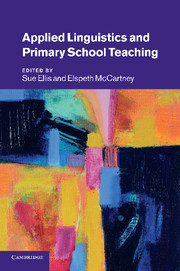Book contents
- Frontmatter
- Contents
- List of figures
- List of tables
- Notes on contributors
- Preface
- Editors' notes and conventions
- Introduction
- Part I Policy and diversity in the twenty-first-century primary school
- Introduction to Part I
- 1 The control of language or the language of control? Primary teachers' knowledge in the context of policy
- 2 Working with children who speak English as an additional language: an Australian perspective on what primary teachers need to know
- 3 Preparing for diversity: the alternatives to ‘linguistic coursework’ for student teachers in the USA
- 4 Supporting children with speech, language and communication needs
- 5 Foreign language teaching in the primary school: meeting the demands
- Part II The range and focus of applied linguistics research
- Part III Empowering teachers and teachers' use of knowledge
- References
- Index
2 - Working with children who speak English as an additional language: an Australian perspective on what primary teachers need to know
Published online by Cambridge University Press: 26 April 2011
- Frontmatter
- Contents
- List of figures
- List of tables
- Notes on contributors
- Preface
- Editors' notes and conventions
- Introduction
- Part I Policy and diversity in the twenty-first-century primary school
- Introduction to Part I
- 1 The control of language or the language of control? Primary teachers' knowledge in the context of policy
- 2 Working with children who speak English as an additional language: an Australian perspective on what primary teachers need to know
- 3 Preparing for diversity: the alternatives to ‘linguistic coursework’ for student teachers in the USA
- 4 Supporting children with speech, language and communication needs
- 5 Foreign language teaching in the primary school: meeting the demands
- Part II The range and focus of applied linguistics research
- Part III Empowering teachers and teachers' use of knowledge
- References
- Index
Summary
Introduction
In this chapter I address questions of what primary school teachers need to know primarily from the perspective of the needs of children for whom English is an additional language (EAL children). In addition, as I am located in Australia, the chapter is very much located within the Australian educational context and in relation to debates that are current in that context.
Australia, like the UK and other developed English-speaking countries, has significant numbers of established and more recently arrived immigrants within its population. General estimates are that around 20 to 25 per cent of children attending school in Australia are from non-English-speaking backgrounds, and significant numbers of these children need support with their development of spoken and written English. Such children tend to be clustered in large urban schools where factors such as poverty and social disruptions also frequently impact on the student populations. As the Organisation for Economic Cooperation and Development International Student Assessment (OECD PISA) results consistently show, there is a correlation between low educational achievement and factors such as socio-background, ethnicity and status as a second language learner (Lokan, Greenwood and Creswell 2000; Thompson and de Bortoli 2006). This is true in Australia, as elsewhere, and the result is that many children from linguistically and culturally diverse backgrounds in Australia do less well in school than their more socially and economically advantaged peers.
- Type
- Chapter
- Information
- Applied Linguistics and Primary School Teaching , pp. 32 - 43Publisher: Cambridge University PressPrint publication year: 2011
- 3
- Cited by

